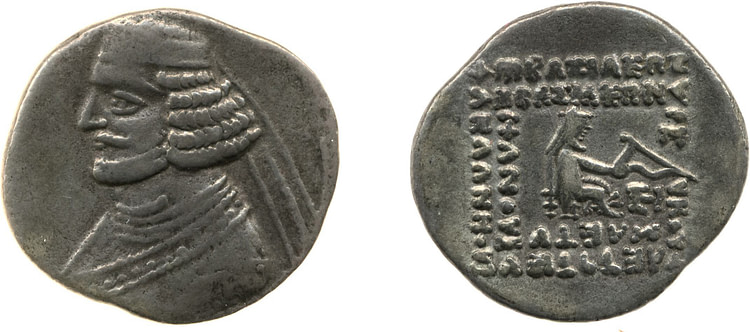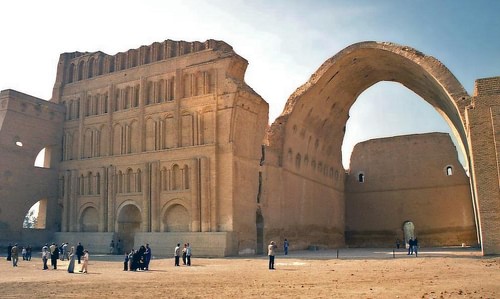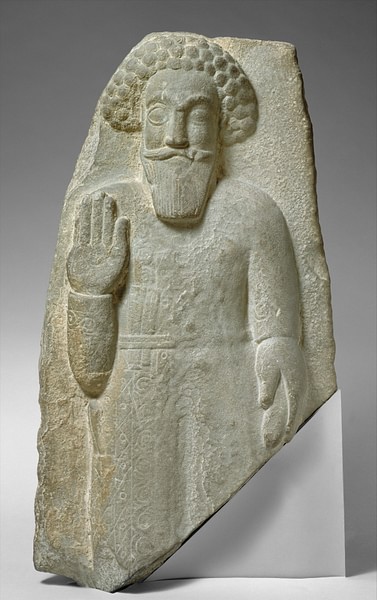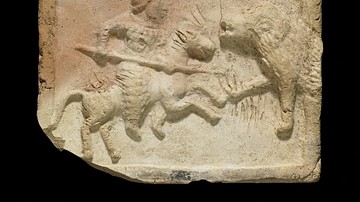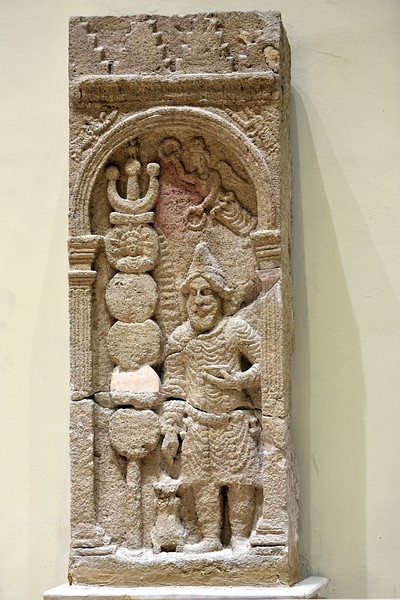
Stretching between China and India in the east to the Mediterranean in the west, Parthia ruled over one of the widest expanses of empire in its time and Parthian culture flourished for 500 years (247 BCE to 224 CE). While known for their military prowess as archers on horseback and creating a sophisticated horse culture, the Parthians were also skilled diplomats. Literate, often multilingual, they ruled with a collaborative spirit, allowing the variety of cultures within their empire the freedom to keep their traditions.
While Jews flourished and Christianity gained a foothold, paganism and the more widespread belief systems of the Greek pantheon and Zoroastrianism also thrived. However, their god of choice was Mithra, who in one person held the attributes of many Greek gods and also became the main deity under Zoroaster's creator god, Ahura Mazda. This gave the Parthians common ground in their relations with Zoroastrians and Greeks alike. Moreover, as the Parthians identified with Mithra because he was a horse-archer, Mithra came to occupy an important niche for the Parthians as they developed their unique cultural identity.
Controlling the lucrative northern east-west silk routes through Mesopotamia, the Parthians were also consummate traders. With that came material reward and status to those conducting the business of the empire. Moreover, while the ruling class enjoyed an elevated level of luxury creating demand for artists and artisans, they also invested in improving existing infrastructure and the building of new. Such buildout would have meant demand for building materials and a need for architects, builders, and masons. While the raised status of the business class would have created its own demand for utility items and luxury goods such standing would have brought material comfort for their families.
A Culture with a Cooperative Spirit
As to the ruling class, it appears Parthia developed an interesting king/noble interaction that gave the nobles political clout not seen until the Magna Carta days of the 1200s CE. As George Rawlinson elucidates,
[Parthian nobles] were no mere creatures of the monarch, but a class which stood upon its own indefeasible rights. They had the privilege of electing to the throne upon a vacancy, and even of deposing a duly elected monarch. Thus, the Parthian nobility were far more powerful and independent than any similar class under the Achaemenian, Sassanian, modern Persian or Turkish sovereigns. (kindle loc 4037)
Consequently, however counterbalancing the king/noble relationship was, it appears it operated without destructive upheaval. While the nobles were given say as to who would be king, the king, if worthy, could rule without question. Thus, king Orodes II (r. 57-37 BCE) ordered the demise of Surena (84-53 BCE), his leading commander who had just won a brilliant battle against the Romans at Carrhae. Though Surena was second only to the king in wealth and was from a prominent family, it appears the king's orders were carried out without objection. On the other hand, when a king failed to protect the empire or ruled irresponsibly, he too could be dispatched without upheaval. After losing influence in Armenia and the province of Gordyene to Rome, and after Pompey's humiliating refusal to address Phraates III (r. 69-57 BCE) by his recognized title "King of Kings," Phraates was killed by his two sons. However, when the elder brother Mithridates IV (r. 57-54 BCE) ruled cruelly, Parthian nobles stepped in to bring Orodes II to the throne.
Moreover, it appears the Parthians were, to an extent, a nation of nobles with a liberal bestowing of noble status. When called to war, we have accounts of some nobles mustering only 125 troops, where others like Surena could bring over 2,000. Thus when it came to the Parthians, while the pride of being a noble was generously conferred and their collective voice held sway, there was an unspoken understanding that respect and obedience to the monarch were essential to ongoing Parthian rule. Moreover, while kings and nobles held a strong sense of shared purpose as Parthians, promoting the Parthian state, a similar cooperative approach was extended to Parthian subjects. As mentioned, Parthia was famous for allowing subject people their own customs and traditions, and it must have been with sophistication their ambassadors practiced their diplomatic skills. An empire like Parthia cannot have ruled as long as it did by might alone; treaties, cooperative agreements, shared military and commercial interests had to be nurtured.
The Art of Diplomacy
An example of Parthia's diplomatic sophistication toward the pride and autonomy of their subject people is seen when they spared Seleucia from having to house Parthia's soldiers. Rather, the town Ctesiphon nearby was built up to do the job. Commercial cooperation with Seleucia's craftsmen and people in business would have been employed and would have profited from the project. This established a greater military presence near Parthia's eastern frontier while also gaining the cooperation of local inhabitants who would benefit commercially during and after the project.
Another example of Parthia's diplomacy comes right off their coins. Many Parthian coins show their kings seated on a throne with an outstretched arm holding a bow. The symbolism would have sent a sophisticated but effective message. The bow was the most effective weapon of Parthian warfare and key to their military might. The image of the bow not aimed, but held out by the king, conveyed Parthia's desire for diplomacy over military action.
Their diplomacy-first policy was tried on the Romans. Before Crassus (115-53 BCE) made his unprovoked attack on Parthia, Parthia made peaceful overtures. Even when Crassus was in Syria on his way into the heart of Parthia, king Orodes II (r. 57-37 BCE) "sent envoys to censure him for the invasion and ask causes of the war" (Cassius Dio, 40.16). Moreover, though they had won decisively against Crassus at Carrhae in 53 BCE and set up the captured Roman standards as a memorial to their victory, the Parthians would later sue for peace. At the behest of Phraates IV (r. 37-2 BCE), a peace agreement was brokered with Augustus in 20 BCE that returned Rome its standards. This treaty would bring decades of peace between the two sides and allowed each to flourish economically.
Thus, though the Parthians had their ups and downs, a certain cooperative spirit from rulers to nobles and from the ruling class to the provinces, served them well. While using their diplomatic skill, the Parthians also needed to benefit their subjects in a tangible way. Like Rome, who offered subject rulers a degree of power and wealth and their people superior infrastructure with roads, Roman baths, and public buildings, the Parthians, in return for tribute and military assistance, also gave something back. Besides allowing their traditions, the Parthian Empire benefited their subjects and themselves with great prosperity and a buildout of existing infrastructure and architecture.
Wealth, Infrastructure & Architecture
Besides the tribute subject nations were expected to give, Parthia's control of the northern east/west silk roads brought them great wealth. Cassius Dio relates Crassus' main reason for attacking Parthia was because they were “exceedingly wealthy” (40:12). That wealth would help them maintain and improve existing edifices and infrastructure and to build anew. While the Parthians have been criticized for lack of expansive building, we must remember they took over an empire with pre-existing Greek and ancient Persian art and architecture. Nevertheless, the Parthians did improve and they did build.
According to Strabo, the Parthians accomplished a significant buildout at Ctesiphon near Seleucia on the Tigris. To spare Seleucia the burden of providing quarters for Parthian soldiers, the Parthians took what was once a village and made Ctesiphon into a city "capable of lodging a great multitude." Besides housing for their soldiers, the Parthians erected many public buildings promoting arts and crafts and other commercial activity "profitable to its masters" (Strabo, 16.1.16). Complete with a palace they built up Ctesiphon to make it practical and worthy of their king's winter residence.
Equally, because of its cooler northerly location, the Parthian kings made Ecbatana their summer stay. Polybius describes, Ecbatana as "superior to other cities in wealth and splendor." At the foot of Mount Orontes, the city contained a citadel "fortified to an astonishing strength." A palace near the citadel was gargantuan and of great beauty. "Covering ground the circuit of which is nearly seven states" (nearly a mile around), the palace beams, columns, fretwork, and ceilings were covered with gold and silver, while the floor tiles were all silver (Polybius 10.27). Though much gold and silver had been stripped by the Parthian period, since it became the king's summer residence, like their improvements at Ctesiphon, the Parthians likely began to return Ecbatana to its former glory.
At Hatra, the Parthians protected the city with an enclosure three miles in circumference. Its walls were exceptionally thick with intervals of square towers every 156 meters (170 yards). Protecting the walls from siege engines and ladders was a very deep and wide dry-moat. The whole complex was additionally protected with two forts on eminences that commanded approaches to the place. So effective were Hatra's fortifications, it repulsed Roman emperor Trajan's attempt on it in 117 CE and Septimius Severus' in 193 and 197 CE. Within the city, the Parthians built a unique, expansive temple the perimeter which is 244 meters (800 ft) long and 213 meters (700 ft) wide.
Similarly, expansion at Merv (Seleucid Antioch) was accomplished with state-of-the-art fortifications of step-shaped battlements and interval towers. In Syria, Parthia made Dura Europas its provincial administrative center, complete with fortified walls, a palace, Mithraim, bazaar, and typical of their multicultural inclination, a Jewish synagogue. Other projects included the reflourishing of ancient cities like Assur, Uruk, and Nimrud, to include adding fabulous houses and temples with barrel vaulting while incorporating the Parthian architectural innovation of vaulted open-ended entryways called iwans. The influence of the Parthian iwan on Middle Eastern architectural design resonates to this day.
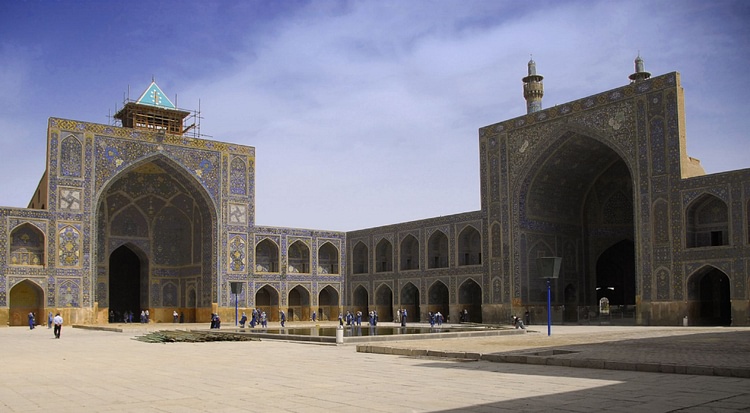
Parthia's Unique Artistic Motifs
Because of their empire's location, and their origins in Central Asia, the Parthians had as their source, a wide range of influences when it came to art and architecture. Borrowing from the east and west, theirs was an amalgam easily identified as Parthian. Their architecture and art employed interesting circular and frontal motifs. Architecturally, the Parthians left in place existing Seleucid structures that naturally copied the Hellenistic rectangular layout with colonnaded and triangular features. However, where it could, the Parthians sought to be different. On entrance to a Greek temple, one passes through a portico of columns. Entering the Parthian temple at Hatra, one arrives under the eye of graceful iwan arches. The blend of Greek-style columns and triangular pediments with multiple Parthian arches at Hatra gives the temple its unique curbside appeal.
At Parthian Assur, the use of Parthian arches is again prominently featured. However, the use of circularity as an architectural feature during the Parthian period pronounces itself in other ways. Reminiscent of the absolute circular Chorasmian fortress at Koi Krylgan Kala (400 BCE to 400 CE) east of the Caspian Sea, whole Parthian towns and fortresses were also laid out in circular fashion. Comparing Seleucid and Persian rectangular planning to some Parthian sites, Malcolm Colledge says:
A very different approach to planning was represented by the vaguely circular shape of several cities under Parthian control or influence, the Parthian re-foundation of Ctesiphon, and the ramparts around Carrhai, Takht-I Suleiman and Hatra of about the first century A.D. were more closely and deliberately, circular. (Parthian Art, 34)
While Parthian architecture uniquely incorporated elements of circularity, their art would include the motif of frontality. In comparison, where works of Egyptian art and Persian figures make statements of power, Greek and Roman models look meditatively away at someone or something. A style Byzantine art would later adopt, Parthian models look straight ahead, making a personal connection between themselves and the viewer. Another distinction is that Parthians often drop the more sober countenance of the Greeks and Romans. Deepening the direct relationship between subject and viewer, some figures appear almost friendly. Moreover, besides the creative fabrication of precious metal jewelry, bronze, terracotta, and stone figures, decorated interior walls are again a testament to Parthian artistic choice and creativity. Wall surfaces at Assur were beautifully adorned with tooled stucco using geometric and floral patterns that are a remarkable precursor of designs adopted by Muslim artists. These decorations would have brightened any room with the application of complementing and contrasting colors.
Parthian Language, Literature & Music
While there is yet no evidence of the Parthians having provided a written history, they certainly were not uneducated. Having ruled over a variety of people, a familiarity by ambassadors, governors, and kings with the customs and language of the people they oversaw would greatly assist military and business communications. Multilingualism is indeed indicated. When Surena found Crassus holed up behind the walls of Carrhae, intent on laying a trap, he sent an emissary with orders to call Crassus out in the Roman tongue. Plutarch says Orodes II himself was "well acquainted with the Greek language and literature" (33.2).
When banquets were held with the king Artavasdes II (r. 55-34 BCE) of Armenia, who aided the Parthians against the Romans, Greek literature was read and enjoyed. Orodes' literacy and proficiency in a foreign language suggest formal schooling. Letters from the king to heads of state in times of war or peace would have been essential to clarify intent. In times of war, orders dispatched from the king to commanders, and from commanders to lieutenants in the field, certainly would not have been delivered by hearsay, but would need the specificity and clarity of written orders. The same would be true of dispatches sent with emissaries on diplomatic missions. Like ambassadors today, literacy and fluency in the language of the people to whom they were assigned would be expected. Additionally, as a commercial juggernaut, written records of business transactions, prolific as they were, had to be advanced, organized, and efficient.
Literacy in a foreign language is further indicated when Josephus mentions sending copies of his book in Aramaic, then in Greek, to the "the upper barbarians" (Wars preface 1.3). Since Josephus wrote much about the Parthians, and the Jews flourished there, it is generally accepted "the upper barbarians" to the north were the Parthians. Finally, as Parvaneh Pourshariati mentions, some credit the Parthians with the codification of an early version of the Zoroastrian holy book, the Avesta. (359)
Though we might think of the Parthian kingdom as possessing serious rulers, driven only to conquer and compete commercially, times of levity and leisure would be equally important. Music and dancing are a part of human culture, and the Parthians were no different. When Surena orchestrated a triumph through Seleucia's streets, singers, dancers, and musicians played a big part. At Parthian feasts, the flute, pipe, and drums were accompanied by the erotic sounds of a stringed instrument called the sambuca. The climax of the celebrations, in harmony and cue with the music, would end with a choreography of dance.
Parthia's Horse Culture
Besides Parthia's other cultural achievements, one might say, theirs was a horse culture. Their single most significant industry may, in fact, have been equine. Their herds had to have numbered in the tens of thousands. Strabo mentions 50,000 mares at the Hippobotus meadow in Media (11.13.7). 11,000 horses were brought to Battle at Carrhae. Media and Parthia deployed 50,000 against Mark Antony in 36 BCE. Horses were everywhere, and many factors would go into play concerning their equine industry: construction of stables, provision of superior feed, horse and rider training, and superior breeding. With such an essential aspect of their military supremacy, royal control of their horse industry would be the norm. Among other mentions by ancient authors of "royal breeds," Polybius mentions royal studs cared for by the Medes (10.27). Strabo compares Parthian horses to the horses of Media, which were "the best and largest in the king's province" (11.13.7). Thus, the best horses would have been reserved for the royal guard and nobles close to the king. Yet breeders and trainers would want to make all Parthian horses and riders the best available.
Secrets of breeding superior studs to superior mares along with expert training techniques would have been a closely guarded process. The heavy cavalry cataphract horse would have been bred for a combination of size, speed, and courage in close combat, while a light infantry horse would be bred for speed and maneuverability. They were the fastest horses around, which meant their light cavalry riders (who practiced archery from early boyhood) could quickly chase down the enemy, or more easily escape when pursued. Strabo also mentions their "ease in speedy traveling" (3.4.15). This not only would have helped the aim of the mounted archer delivering kill shots at full gallop but, just as important, it meant the rider would not be worn out from a choppy gaited horse. That Parthian horses were superior to others and key to Parthia's military supremacy reveals ownership of a highly organized horse industry that produced superior animals while using state of the art training methods for horse and rider.
Conclusion
The Parthians, in a way, have been given a bad rap. At one end, their conquerors, the Sassanian Empire, sought to destroy their material and cultural legacy. At the other end, we get an incomplete history by the Romans and Greeks. Yet with archaeological discovery and new scholarship, Parthia's level of cultural sophistication is beginning to unfold. As Pourshariati states,
In art, architecture, and even traditions of rule, the Parthian contribution to subsequent Iranian culture and to the cultural traditions of the regions as a whole are being gradually and increasingly established. (24)

